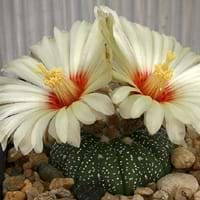What is
Life Span
Perennial
Perennial
Type
Vegetable
Cactus, Flowering Plants
Origin
Hybrid origin, Mexico, Central America, South America
Mexico, Texas
Types
Not Available
Not Available
Habitat
Coastal Regions
Desert, In desert grasslands, Rocky areas
USDA Hardiness Zone
11-15
13-15
AHS Heat Zone
12-1
12-10
Sunset Zone
A1, A2, A3, H1, H2, 1a, 1b, 2a, 2b, 3a, 3b, 4, 5, 6, 7, 8, 9, 10, 11, 12, 13, 14, 15, 16, 17, 18, 19, 20, 21, 22, 23, 24
21,22,23,24
Habit
Upright/Erect
Oval or Rounded
Information
Plant Size
Minimum Height
150.00 cm
99+
Not Available
Minimum Width
60.00 cm
99+
Not Available
Plant Color
Flower Color
Yellow
Red, Yellow
Flower Color Modifier
Bicolor
Not Available
Fruit Color
Red
Green, Pale Pink
Leaf Color in Spring
Green, Dark Green
Not Available
Leaf Color in Summer
Green, Dark Green
Not Available
Leaf Color in Fall
Green, Dark Green
Not Available
Leaf Color in Winter
Green, Dark Green
Not Available
Shape
Leaf Shape
Ovate
Not Applicable
Thorns
No
Not Available
Season
Plant Season
Spring, Summer, Fall
Not Available
Growing Conditions
Sunlight
Full Sun
Not Available
Growth Rate
Fast
Not Available
Type of Soil
Loam, Sand
Not Available
The pH of Soil
Neutral
Not Available
Soil Drainage
Well drained
Not Available
Bloom Time
Indeterminate
Not Available
Repeat Bloomer
Yes
Not Available
Tolerances
Drought
Not Available
Care
Where to Plant?
Container, Ground
Ground
How to Plant?
Grafting, Seedlings
Seedlings, Transplanting
Plant Maintenance
Medium
Medium
Watering Plants
Watering Requirements
Needs more water during establishment
Needs very little water
In Summer
Lots of watering
Lots of watering
In Spring
Moderate
Moderate
In Winter
Average Water
Average Water
Soil
Soil pH
Neutral
Not Available
Soil Type
Loam, Sand
Not Available
Soil Drainage Capacity
Well drained
Not Available
Sun Exposure
Full Sun
Not Available
Pruning
Pinch or prune as they grow to promote branching and bushiness
Remove damaged leaves, Remove dead branches, Remove dead leaves
Fertilizers
14-14-14 Fertilizer, Compost
All-Purpose Liquid Fertilizer
Pests and Diseases
Anthracnose, Aphids, Red blotch, Rust
Dry root rot, Root mealy bugs
Plant Tolerance
Heat Tolerance, Salt and Soil Compaction
Drought
Facts
Flowers
Showy
Yes
Flower Petal Number
Single
Not Available
Fruits
Showy Fruit
Yes
Not Available
Edible Fruit
Yes
Not Available
Fragrance
Fragrant Flower
Yes
Not Available
Fragrant Fruit
Yes
Not Available
Fragrant Leaf
Yes
Not Available
Fragrant Bark/Stem
Yes
Not Available
Showy Foliage
No
Not Available
Showy Bark
No
Not Available
Foliage Texture
Medium
Bold
Foliage Sheen
Matte
Not Available
Evergreen
No
No
Invasive
No
Not Available
Self-Sowing
Yes
Not Available
Attracts
Aphids, Not Available, Squirrels
pollinators
Allergy
Stomach pain, Vomiting
Not Available
Benefits
Uses
Aesthetic Uses
Used in parkland
Beautification, Showy Purposes
Beauty Benefits
Anti-ageing, Blackheads, Reduce Bruises
Not Available
Edible Uses
Yes
No
Environmental Uses
Shadow Tree, Soil protection
Air purification
Plant Benefits
Medicinal Uses
Dehydration, Diabetes, Diarrhea, Nutrients, Weight loss
Not Available
Part of Plant Used
Fruits
Flowers
Other Uses
Application in Handicrafts, Food for animals, Showy Purposes
Used as Ornamental plant
Used As Indoor Plant
No
Yes
Used As Outdoor Plant
Yes
Yes
Garden Design
Edible, Herb, Vegetable
Not Available
Scientific Name
Botanical Name
Manilkara zapota
Astrophytum asterias
Common Name
sapodilla , chikoo, Sapota
Star Cactus, Sand Dollar Cactus
In Hindi
चीकू
रेत डॉलर कैक्टस
In German
Breiapfelbaum
Sand Dollar Cactus
In French
Sapotillier
Sand Dollar Cactus
In Spanish
chicle
Sand Dollar Cactus
In Greek
sapodilla
Sand Dollar Cactus
In Portuguese
sapodilla
Cacto do dólar de areia
In Polish
Pigwica właściwa, sapodilla
Sand Dollar Cactus
In Latin
sapodilla
Sand Dollar Cactus
Classification
Kingdom
Plantae
Plantae
Phylum
Magnoliophyta
Magnoliophyta
Class
Magnoliopsida
Magnoliopsida
Order
Ericales
Caryophyllales
Family
Sapotaceae
Cactaceae
Genus
Abelia
Astrophytum
Clade
Angiosperms, Asterids, Eudicots
Angiosperms, Core eudicots, Eudicots
Tribe
Sapoteae
Cacteae
Subfamily
Sapotoideae
Cactoideae
Number of Species
134
99+
6
99+
|
||
|
||
|












